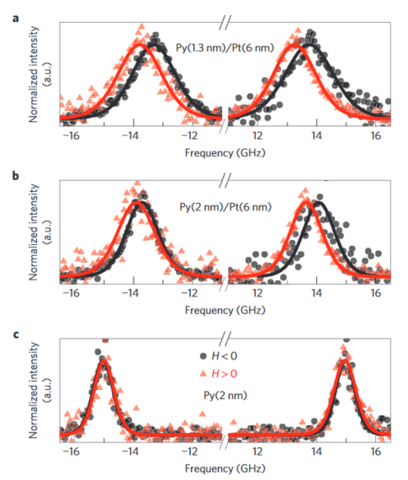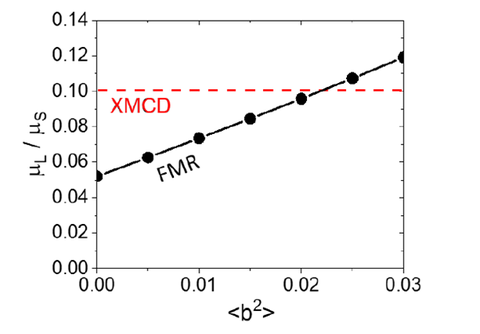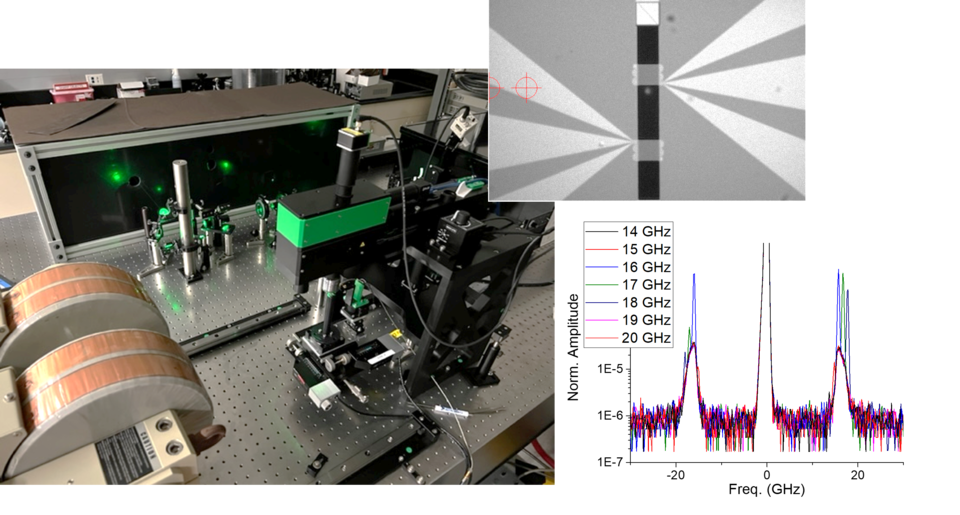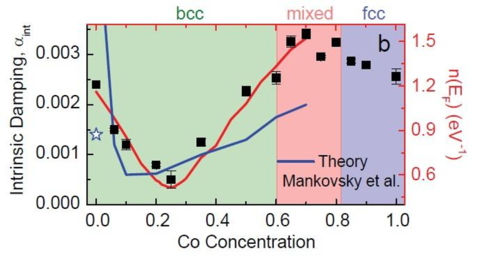Summary
The Optical and Microwave Spectroscopy of Microelectronic Systems program in the Spin Electronics group applies best-in-the-world and novel microwave and optical spectroscopy techniques to provide accurate measurement of critical material and device parameters needed to generate predictive models of spintronic device performance.
Description
Collaborations with industry leaders have led to new understanding of magnetic damping in advanced materials and replication of our magnetic metrology tools. We investigate fundamental aspects of spin transfer in materials and structures that offer improved performance in future devices such as emerging non-volatile magnetic memories and logic devices with low energy consumption. These studies include best-in-the-world measurement of energy dissipation, spin-orbit torques, spin and magnon transport, and fundamental measurement of critical parameters such as Heisenberg exchange and spin-mixing. We employ a combination of precision microwave spectroscopy that is often coupled with optical measurements via Brillouin light scattering (BLS) and novel NIST-developed dynamic magneto-optical approaches.
Major Accomplishments

Optical measurement of exchange and saturation magnetizatio
Thermal fluctuations are the main limitation to the scalability to nonvolatile magnetic memory. To achieve reliable writing of bits and prevent thermal erasure of a bit in a magnetic memory element, it is imperative that the magnetization in in a uniform "single-domain" state. Several mechanisms play a critical role to maintain the orientation of a magnetic bit. Two of the most elusive materials parameters are the symmetric and anti-symmetric exchange interactions – the so-called Heisenberg exchange and Dzyaloshinskii-Moriya interaction (DMI), respectively. The latter can originate from ferromagnet/heavy metal (FM/HM) interfaces. While the symmetric exchange favors a colinear orientation of the magnetization, the DMI favors chiral magnetization orientation, greatly reducing the thermal stability of magnetic memory. Hence, quantitative measurement techniques are required to characterize the Heisenberg exchange and the DMI at different FM/HM interfaces to ensure that the particular FM/HM combination does not result in an excessively large DMI. However, accurate and quantitative measurement of these exchange parameters has long been elusive, especially in technologically relevant ultra-thin films that only have a thickness of a few nanometers to less than a nanometer. Here, we have developed new measurement approaches that can now accurately measure both the symmetric and antisymmetric exchange parameters using Brillouin light scattering (BLS). Most importantly, this optical spectroscopy approach measures these parameters locally, to a region limited only by the spot size of the laser beam. This allows for the potential use as inline wafer inspection tool that can be deployed in microelectronic fabrication facilities.
Publications:
- Grant Riley, Justin Shaw, Thomas Silva, Hans Nembach, “Simultaneous measurement of the exchange parameter and saturation magnetization using propagating spin waves” Applied Physics Letters, 120, 112405 (2022) doi: 10.1063/5.0083583
- Grant Riley, Justin Shaw, Thomas Silva, Hans Nembach” METHOD AND SYSTEM FOR DETERMINING AT LEAST ONE PROPERTY OF MAGNETIC MATTER” International Patent Pending (PCT/US21/49176)
- H. T. Nembach, J. M. Shaw, M. A. Weiler, E. M. Jué, and T. J. Silva, "Linear relation between Heisenberg exchange and interfacial Dzyaloshinskii–Moriya interaction in metal films," Nature Phys. 11, pp. 825-829 (Aug 2015), doi:10.1038/nphys3418

First time measurement of the spin-mixing parameter
Spin-mixing, parameterized by the spin mixing coefficient <b2>, is ubiquitous in condensed matter systems despite being elusive to experimental observation. Mixing of the two spin eigenstates, up and down spin, has profound effects on material properties and quantum / spintronic applications, yet there are few experimental tools to quantify <b2> and feed those values back into advanced band-structure calculations. In our recent groundbreaking discovery, we along with our collaborators at Univ. South Florida and Uppsala Univ. in Sweden showed that a combination of high-precision measurements of ferromagnetic resonance and x-ray spectroscopy can experimentally determine <b2>.
Prior to this discovery, experimental evidence of the spin-mixing parameter has been obtained indirectly through phenomenological modeling of spin-scattering via the Elliott-Yafet description often invoked to explain ultra-fast magnetization dynamics. However, quantification of <b2> with ultra-fast experiments is highly model dependent with many adjustable parameters and as such questionable. Competing techniques such as high-resolution ARPES and spin-resolved ARPES are applicable to specialized materials, typically prepared in-situ or with freshly exposed surfaces from cleaving of single crystals, both of which limit the range of materials that can be studied, and which prevent these techniques from directly addressing the effects of complex heterostructures and electronic gate structures on band structure evolution. As a result, band structure calculations have been the primary means to quantify <b2> , despite the lack of feedback and/or validation from experiment. Here, for the first time NIST can provide the necessary feedback to the theory.
Publication:
- Justin M. Shaw et al., “Quantifying Spin-Mixed States in Ferromagnets” Physical Review Letters, 127, 207201 (2021) doi:10.1103/PhysRevLett.127.207201
Local optical spectroscopy of spin-wave propagation in high-frequency devices
Spin-waves or magnons are magnetic excitations with a wide range of applications spanning from microwave devices for radar to spin-wave based computation. These different research directions are generally summarized under the term magnonics. Important characteristics of spin-waves are their velocity, propagation length and their excitation through high-frequency antennas. The non-reciprocal propagation of spin-waves, meaning that their amplitude and frequency are altered, when propagating in opposite directions, is of great interest for magnonic devices, which include isolators and circulators. Here, we are probing spin-waves optically with a micro-focus Brillouin Light scattering spectrometer (micro-BLS) with diffraction limited spatial resolution. This allows us to directly measure the fundamental properties of spin-waves without the need to infer them from in-direct electrical measurements. Most recently, we have studied the efficiency of antenna designs to launch spin-waves.
Spin-waves can be also employed as a probe for fundamental magnetic properties. The relaxation rate or damping of magnetic excitations can depend on their wavelength and can be investigated by studying spin-wave propagation.
The micro-BLS is equally sensitive to lattice excitations and has the potential to measure spatially resolved lattice excitations. This enables us to study heat transport and phononic structures to engineer thermal properties of microelectronics devices.


Discovery of Ultra-Low Damping in Magnetic Metals and Half-Metals
The magnetic damping parameter in magnetic materials is a measure of how quickly energy dissipates in spin excitations. The development of materials with ultra-low damping is critical for the reduction of the power required to switch magnetic bits in future nonvolatile magnetic random-access memory. Such magnetic memory is expected to play a vital role in the future growth of the “Internet of Things,” where the ubiquity of extremely low power processors in virtually everything will usher-in a new era of consumer electronics.
We have discovered that the electron band structure at the Fermi energy controls damping in metallic and half-metallic alloy systems. This insight led us to the discovery of ultra-low damping in a simple cobalt-iron binary alloy. The damping parameter for the alloy is almost an order of magnitude lower than the smallest reported value for any other metal. The discovery was facilitated by the use of a ferromagnetic resonance spectrometer with world-record sensitivity that we developed. Prior to this result, it was generally believed that ultra-low damping was not possible for conductors because of coupling between magnetic spin waves (magnons) and the momentum of conduction electrons. Such spin-momentum coupling tends to draw energy more readily out of the magnetization. However, along with collaborators at Uppsala University in Sweden, we found that the newly discovered alloy has a particular band-structure feature that leads to ultra-low damping despite the presence of conduction electrons. The identification of this key feature in the band-structure provides a framework for the future discovery of new alloys and compounds with even lower values of damping.
Publications:
- J. M. Shaw, E. K. Delczeg-Czirjak, E. R. J. Edwards, Y. Kvashnin, D. Thonig, M. A. W. Schoen, M. R. Pufall, M. L. Schneider, T. J. Silva, O. Karis, K. P. Rice, O. Eriksson, and H. T. Nembach, “Magnetic damping in sputter-deposited Co2MnGe Heusler compounds with A2, B2 and L21 order: Experiment and theory.” Physical Review B, 97, 094420 (2018)
- M. A. W. Schoen, D. Thonig, M. L. Schneider, T. J. Silva, H. T. Nembach, O. Eriksson, O. Karis, and J. M. Shaw, “Ultra-low magnetic damping of a metallic ferromagnet,” Nature Physics, 12, 839-842 (May 2016), doi: 10.1038/nphys3770

